
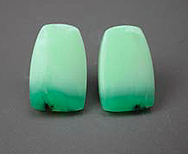
Chrysoprase is chalcedony (microcrystalline quartz) whose rich green color is derived from the presence of minute particles of a nickel containing mineral, willemseite. The derivation of its beautiful color is, then, analogous to chrysocolla chalcedony's coloration by particles of the copper mineral chrysocolla. Chrysoprase, with nickel as a chromophore, is notable among green stones as the majority are colored by iron (like peridot), or chromium (like emerald and chrome tourmaline), or vanadium (like Tsavorite garnet).
Geologically it forms as a precipitate from solutions containing silica and nickel compounds, generally derived from the weathering of serpentines. These solutions crystallize in fissures, cracks and cavities in various types of rocks. Historically deposits have been found in Eastern Europe, the US, Russia and Brazil, but by far the lion's share of today's World chrysoprase production comes from Australia.
The name, derived from Greek for "golden + leek" belies the green color, but may have reflected either yellowish local deposits, or as so often happens in gemological antiquity, the transfer of names from one gem material to another as time passed. Colors range from near emerald, to apple, to leek green, with or without matrix, and diaphaniety ranges from nearly transparent to opaque.


At one time the duller, leek green stones were called prase, and the more vivid apple greens ones chrysoprase, but this distinction is given little attention today.

Most commonly we encounter this gem as translucent cabochons or carvings in its apple green color.

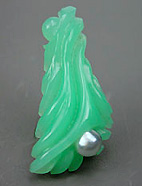

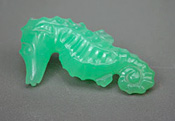
The appearance of the best colored pieces is similar to that of fine jade, and explains the high regard this stone inspires in the Orient. In fact, unscrupulous sellers of both contemporary and vintage jewelry have been known to sell chrysoprase as the more valuable jadeite. Looking at the two rings below, it is not immediately obvious which is chrysoprase and which is jadeite.
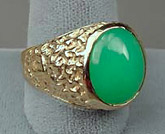
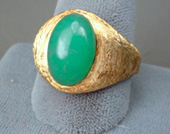
A rare, related chalcedony in darker, less saturated shades of green, that is colored by chromium occurs in Zimbabwe and is called Mtorolite, but sometimes is sold as "African chrysoprase".

Like other forms of chalcedony, chrysoprase makes a good, tough, gem for all jewelry applications. The only concern is that some specimens may lose a bit of their color if they are exposured to prolonged high heat or intense light. Chrysoprase, itself, is not known to be treated or enhanced; however dyed green agate, and green glass have been commonly used as simulants.
With the exception of the finest grades of
chrysocolla chalcedony, chrysoprase is the most valuable variety
among the chaledonies. The most desirable gems in this material
feature an even, highly saturated color with substantial translucency
and no visible inclusions. Custom cut specimens are more valuable
than calibrated cuts and larger pieces of high quality are rare.